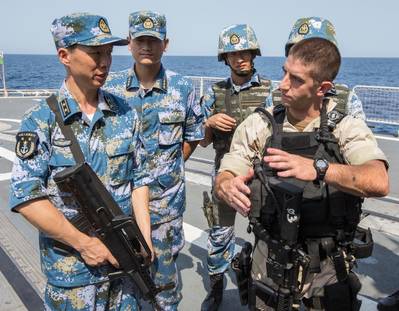US & China Join in Counter-piracy Exercises
The guided-missile destroyer 'USS Mason' (DDG 87) personnel participated in a counter piracy exercise in the Gulf of Aden with elements of the Chinese People's Liberation Army (Navy) (PLA(N)), aboard the destroyer 'Harbin' and Chinese auxiliary replenishment oiler Weishanhu (AO 887).
Mason joined Chinese destroyer Harbin (DDG 112) and Chinese auxiliary replenishment oiler Weishanhu (AO 887) to conduct a series of evolutions including combined visit, board, search and seizure (VBSS), live-fire proficiency, and aviation operations to enhance bilateral interoperability in the U.S. 5th Fleet area of responsibility (AOR).
The U.S. Navy and People's Liberation Army (Navy) share a common interest in preserving legitimate mariners' access to, and secure use of, the maritime domain by deterring, disrupting and suppressing piracy," said Vice Adm. John Miller, commander, U.S. Naval Forces Central Command (NAVCENT), U.S. 5th Fleet, Combined Maritime Forces. "Both regional and global security environments call for practical cooperation between navies, and this exercise demonstrates a cooperative effort by the U.S. and China to address common maritime security challenges."
The Chinese oiler played the role of a pirated vessel as VBSS teams from both Mason and Harbin performed two boardings as a combined unit. The U.S.-Chinese team successfully completed the VBSS evolutions that included mock medical emergency and hostage scenarios.
"Watching U.S. and Chinese sailors working side by side was amazing," said Cmdr. Wilson Marks, Mason's commanding officer. "We may come from different places and speak different languages, but at the end of the day, we all share a common interest in protecting the maritime domain."
The ships applied synchronized maneuvering techniques during a live-fire exercise involving an inflatable target. Mason and Harbin successfully engaged the target with the 5-inch MK-45 lightweight gun and 3.9-inch ENG-2 deck gun.
U.S. and PLA(N) helicopters also conducted cross-deck landing qualifications. These were the first ever such exchanges in which the U.S. and Chinese forces practiced interoperability in a major exercise.

















